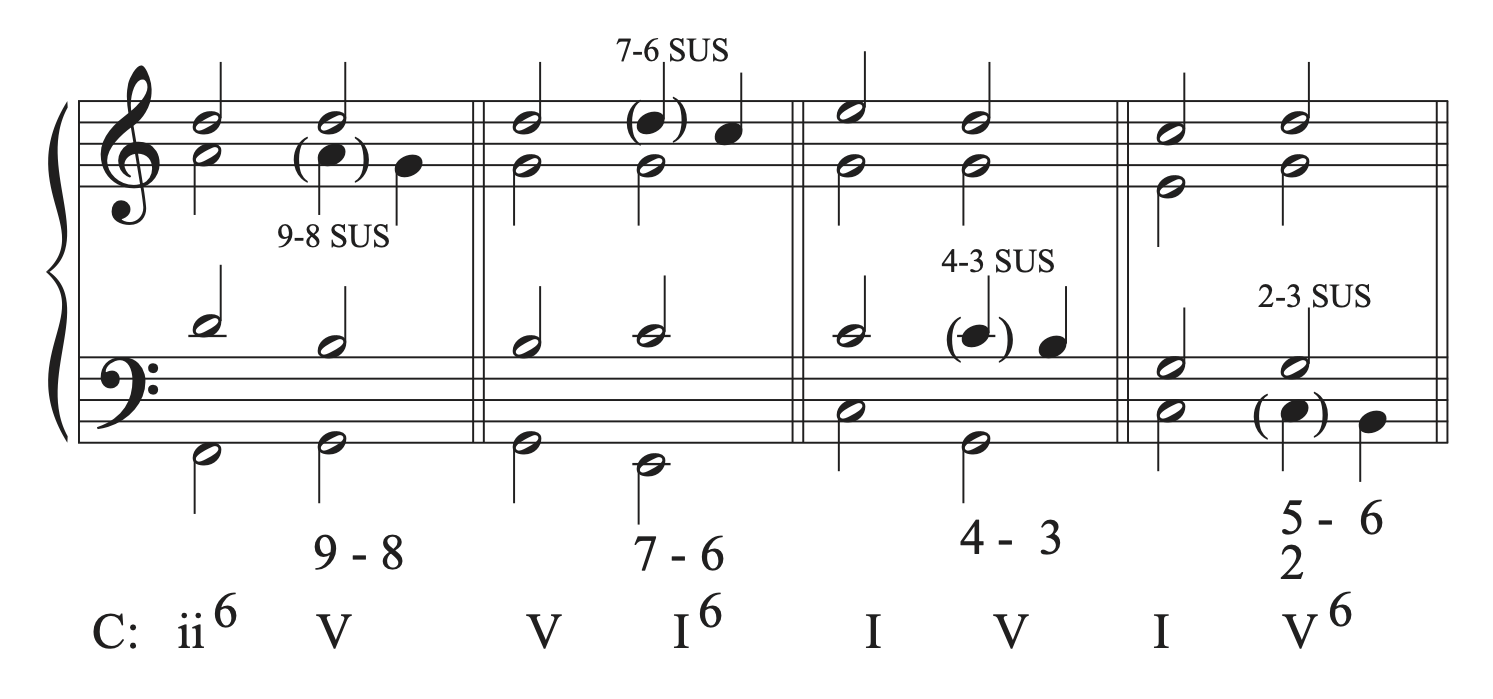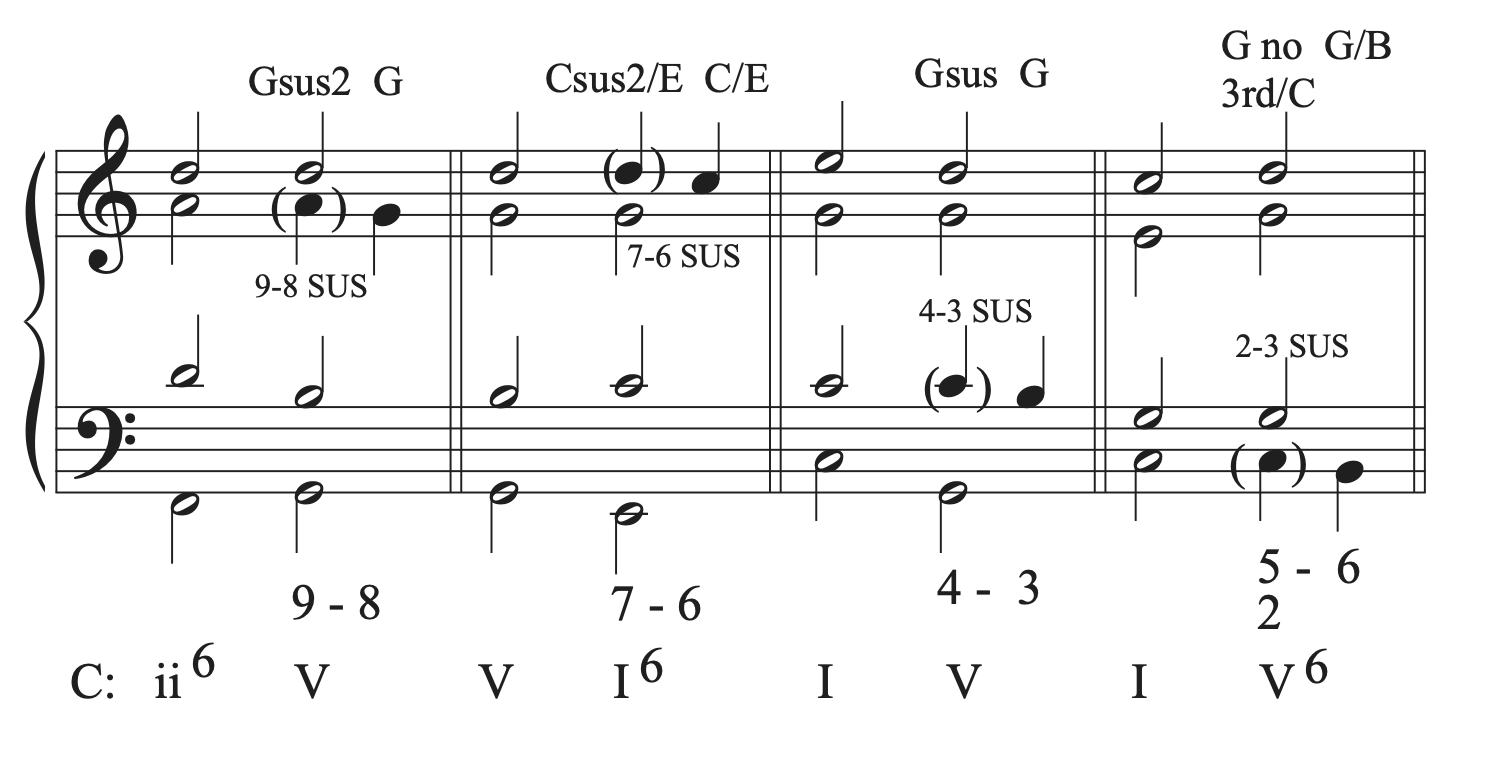10.6 Part Writing, Non-Chord Tones: Tutorial
Part Writing with Non-Chord Tones
To review non-chord tones, see chapter 7.3.
Guidelines for using Non-Chord Tones (NCTs) in Part Writing
- Do not use a NCT to avoid a part writing error. Check for and resolve errors before inserting NCTs.
- For clarity, do not write more than one NCT between the same two chords.
- When part writing with NCTs, complete the part writing without NCTs first, then look for places to insert NCTs.
Where to insert NCTs
When inserting non-chord tones, look for the following types of motion:
- Suspension: stepwise motion down
- Retardation: stepwise motion up
- Anticipation: any motion
- Passing Tone: two pitches at least a major second apart
- Neighbor Tone: same pitches
- Double Neighbor: same pitches
- Appoggiatura: ability to leap, then step on a strong beat/part of the beat
- Incomplete Neighbor: ability to leap then step on a weak beat/part of the beat
- Escape Tone: ability to step, then leap
Label all NCTs appropriately
- Put a parenthesis around the NCT (only around the actual non-chord tone or tones)
- Label the NCT
- Make sure to label suspensions with the number of the suspension as well as “SUS”
Figured Bass and Lead Sheet symbols with NCTs
Usually, suspensions are the only NCTs indicated in figure bass. The list below shows the typical figured bass symbols for each suspension.
- 9-8 suspension figured bass symbol: 9-8
- 7-6 suspension figured bass symbol: 7-6
- 4-3 suspension figured bass symbol: 4-3
- 2-3 suspension figured bass symbol: 5/2-6

Lead-Sheet symbols indications for suspensions
The list below shows the common lead sheet symbols used for suspensions. Suspensions will use one lead sheet symbols for the suspension itself, and another lead sheet symbol for the resolution.
- 9-8 suspension lead sheet symbol: sus2
- 7-6 suspension lead sheet symbol: sus or sus4
- 4-3 suspension lead sheet symbol: sus2/
- 2-3 suspension lead sheet symbol: no 3rd/

The “Sus” numbers used in lead sheet symbols are equal to the interval formed by the note above the ROOT of the chord (not necessarily the note in the bass).
- 9-8 suspension: “sus2” refers to a triad in which the third has been replaced by a second (C D G).
- 4-3 suspension: “sus4” refers to a triad in which the third has been replaced by a fourth (C F G).
- “sus” alone refers to a 4-3 suspension
- 7-6 suspension: “sus2/” refers to a chord in 1st inversion in which the root has been replaced by a second
- 2-3 suspension: refers to a first inversion chord with no 3rd over the suspended note followed by a first inversion chord
Common mistakes when part writing with NCTS
- NCTs have to be non-chord tones. Check to make sure that the note you choose are not chord tones.
- Do not put more than one NCT in the same spot. It muddies the harmony and sound.
- Make sure that all rhythm adds up correctly and that all chords line up vertically in the bar.
- Check for part writing errors both with and without the NCTs. You can’t use a NCT to avoid an error.
- Suspensions have 2 lead sheet symbols: one for the suspension and one for the resolution chord.
- Check the doubling. Normal doubling rules still apply when using NCTs
Guidelines to using NCTS when part writing
- Part writing must be correct, both without the NCT and with the added NCT. You cannot use a NCT to avoid part writing errors.
- Non-chord tones need to be one of the types found in music:
- Passing tone
- Neighbor tone
- Double neighbor
- Appoggiatura
- Incomplete neighbor
- Escape tone
- Anticipation
- Suspension
- Retardation
- Pedal tone
- Make sure to label all NCTS with parenthesis or a circle around the note or notes that are the non-chords and a label that abbreviates the type of non-chord tone used.
- Do not use more than one NCT in any one spot on or between two chords. It muddies the harmonies and sound, and can create unwanted harmonies.
- Do not add NCTs between the chordal seventh in any seventh chord and its resolution note. It needs to resolve down by step in the same voice to the next chord.
- When adding NCTs to a progression, look for places to use NCTS that have the strictest type of motion first (like suspensions).
- Make sure each NCT added is actually a NCT and is not part of the chord.
Proceed to theory exercises for guided examples for part writing with NCTs.

